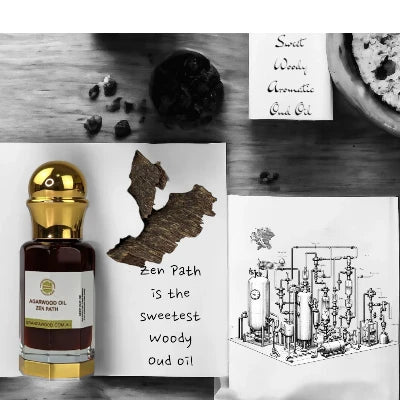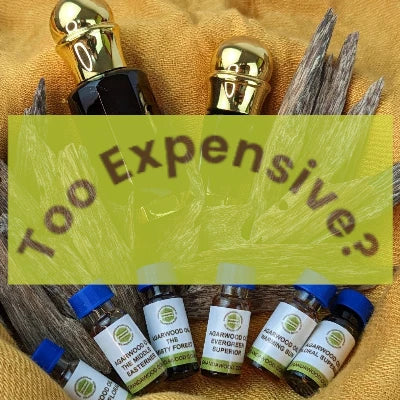Menu
-
-
F.A.Q
- How to identify genuine agarwood chip, natural or cultivated
- How to identify oil injection / absorption fake agarwood beads
- How to know if there are more than one oil in your oil
- How to make your wood bracelet or mala darker
- How to tell if an Agarwood bead sinks WITHOUT sinking it under water?
- How does back flow incense work and how do you burn it?
- Where to start if you don't know what agarwood is ?
- Why are you losing money if you buy seeds and plants?
- Which agarwood incense should I choose?
- Frequently Asked Questions
- Agarwood Related Articles
- Shipping
-
SHOP - Agarwood
-
SHOP - Other Fragrant Wood
-
SHOP - Incense Holder and Burner
-
- FREE guide book
- Testimonials
- "Why did you buy this?"
- Contact us
- About Us
- +61430284329
- Login
-
English


How long does Agarwood oil (Oud) last on your skin?
August 16, 2023 6 min read
Hi friend, oud lover, oud discoverer
I often receive a similar question from SMS, WhatsApp, online chats, and email: "How long does oud oil last on my skin?"



So today, I would like to address this question.
The way oud oil manifests and lasts on different individuals' skin is influenced by many factors, some of which are particular to the unique nature of oud.
Skin Type:
| Skin Type | Oud Oil Retention | Notes |
|---|---|---|
| Oily Skin | Longest duration | The oil on the skin can bond with oud, making the scent last longer. |
| Dry Skin | Shortest duration | Lack of natural oils can cause the oud to evaporate more quickly. |
| Combination Skin | Moderate to long duration | The oily parts (forehead, nose and chin) may retain the scent longer than the drier areas. However, with Oud oil, people apply around the neck, earlopes, or on the wrist. |
| Normal Skin | Moderate duration | Balanced sebum and moisture level allows for a more predictable scent duration. |
- Oily vs. Dry: Oud oil blends better with the natural sebum on oilier skin. This can result in a more pronounced and lasting scent. On drier skin, oud might not be as radiant or long-lasting since there's less natural oil for it to mingle with.
At the molecular level, everything we perceive as scent is due to volatile compounds interacting with olfactory receptors in our noses. The rate at which these compounds volatilize (turn into vapour) plays a significant role in how long and how well we can detect them.
Oily Skin:

- The skin's sebum (the natural oil produced by our sebaceous glands) primarily comprises triglycerides, wax esters, squalene, and free fatty acids. When oud oil is applied to oily skin, its molecules can interact and mix with these sebaceous secretions.
- This interaction effectively reduces the volatility of the aromatic compounds in Oud oil, slowing down the rate at which they evaporate. Think of it as a slow-release mechanism. The more these molecules are "trapped" within the sebum, the longer they will emit their aroma, leading to a prolonged and often more intense scent profile.
- Additionally, the fatty nature of sebum can act as a solvent, which can potentially modify the scent profile of oud, emphasizing certain notes while suppressing others.
Imagine you have shiny, glossy paper (like photograph paper). If you put a drop of coloured water on it, the colour will stay bright and won't fade away quickly. That is because the shiny paper does not let the water spread out too fast. This is like oily skin holding onto the oud aroma longer because of the natural oils on it.
Dry Skin:

Source: designundfotoar Pixabay
- Dry skin lacks ample sebum, so there's less for the oud oil to interact with. Without this layer of natural oil, the aromatic molecules in the oud are more exposed to the environment.
- As a result, the molecules tend to volatilize more rapidly, leading to a faster evaporation rate. This quick evaporation often means that the scent might not last as long on dry skin.
- Furthermore, the absence of adequate sebum means that there's no modifying agent to play with the scent profile of the oud. As such, while the scent might be truer to the original profile of the oil, it may not have the same depth or complexity as it would on oilier skin.
Now, think about a regular piece of paper from your notebook. If you drop coloured water on it, the colour will spread out and fade faster. This is similar to dry skin, which doesn't have much oil. So, the oud smell might go away more quickly.
Skin's pH Level:
The natural pH of an individual's skin can affect how oud oil smells and lasts. If someone's skin is more acidic, it might subtly change the aromatic profile of the oud, possibly making certain woody or resinous notes more dominant.
pH stands for 'potential of hydrogen' and it represents how acidic or alkaline a substance is on a scale of 0 (very acidic) to 14 (very alkaline), with 7 being neutral (like distilled water). Human skin typically has a pH value that ranges from 4.5 to 6.5, making it slightly acidic.
Chemical Interactions:
The aromatic compounds in oud oil are composed of different molecules, each with its own chemical properties. When applied to the skin, these molecules encounter the skin's slightly acidic environment. Depending on the skin's pH, these molecules can undergo subtle chemical changes.
For instance, some aromatic molecules might become protonated (i.e., they acquire an extra hydrogen ion from the acidic environment) or deprotonated (lose a hydrogen ion). These chemical changes can alter the volatility and aroma of the molecules.
Volatility of Aromatic Compounds:
The skin's pH can influence the rate at which certain aromatic compounds in oud oil evaporate. For example, molecules that have undergone protonation due to an acidic environment might have altered volatility, changing how quickly they evaporate and, thus, the perceived intensity and longevity of the scent.
Modification of Scent Profile:
The interaction between the skin's pH and the aromatic compounds can lead to shifts in the scent profile. Some notes might become more pronounced, while others might recede. For instance, as mentioned, more acidic skin could emphasize the woody or resinous notes of the oud, possibly due to the way specific compounds in these notes react to the skin's acidity.
Solubility of Aromatic Compounds: The solubility of certain compounds in oud oil might be affected by the pH. If a molecule becomes more soluble due to the skin's pH, it might interact more with the skin's moisture and oils, which can lead to a shift in how the scent is released and perceived.
Environmental Factors and Oud Oil:
-
Dry Weather:
- Oud oil dries up faster.
- You will mostly notice the lighter, fresh smells of the oud because they evaporate quickly.
- Because the skin doesn't have much moisture, you'll get a clear and direct smell of oud.
-
Humid Weather:
- Oud oil stays on longer because of all the moisture in the air.
- You will feel the deeper, woodier aroma more because they stick around while other lighter top notes are subdued.
- Since our skin is moist in this weather, the oud oil might mix with sweat, changing how it smells a bit.
- Ideal condition for bacteria growth which is in our sweat, this will change the oud notes also.
-
Balanced (or Middle) Weather:
- Oud oil evaporates at a regular pace.
- You'll experience both the light and deep smells of oud, giving you a full journey of its scent.
- The skin is neither too dry nor too moist, making oud smell just right.
In simpler terms: Think of oud oil as a musical band. In dry weather, the lead singer's voice (lighter smell) stands out but does not last long. In humid weather, the background instruments (deeper smells) dominate, and the lead voice might get drowned out a bit. In balanced weather, the entire band plays in harmony, and you get to enjoy the complete song!
Here is the summary
| Climate/ Weather | Evaporation Rate | Aromatic Interaction | Skin Interaction | Overall Effect on Oud Smell |
|---|---|---|---|---|
| Dry | - Faster evaporation of top and middle notes. | - Aromatic molecules have direct interaction with skin and air, leading to a "pure" scent profile. | - Reduced skin moisture, emphasizing subtler notes. | - More pronounced delicate and nuanced notes due to rapid evaporation of top and middle notes. |
| Humid | - Reduced evaporation, especially of base notes. | - Hygroscopic compounds absorb moisture, possibly altering aroma. - Potential for mold/microbial growth in presence of other ingredients. |
- Skin retains more moisture, altering the oud oil spread and interaction. - Increased perspiration can mix with oud, potentially altering scent. |
- Amplification of deeper, woody, and resinous notes. Some subtler nuances might be overshadowed. |
| Balanced (Temperate) | - Balanced evaporation rate, with a harmonious transition from top to base notes. | - Oud oil molecules remain relatively stable, ensuring a consistent scent. | - Stable skin hydration allows even spread and interaction of oud oil. | - Comprehensive olfactory experience, showcasing both the intricate nuances and the deeper tones of oud. |
Summary
Oud oil's duration on skin can vary widely, ranging from as short as 30 minutes for some individuals to lasting eight hours for others due to the above factors.
Leave a comment
Comments will be approved before showing up.
Also in News

Anoint with The Zen Path, and you will never yearn for the artificiality that numbs the senses
March 03, 2024 2 min read

You say: “Your Agarwood is too expensive”. Let’s Reason Together - about Price
February 14, 2024 8 min read
